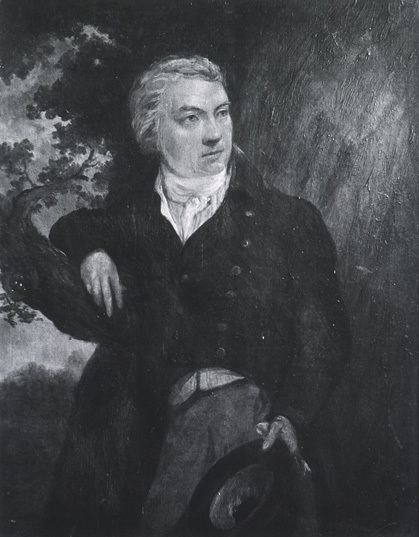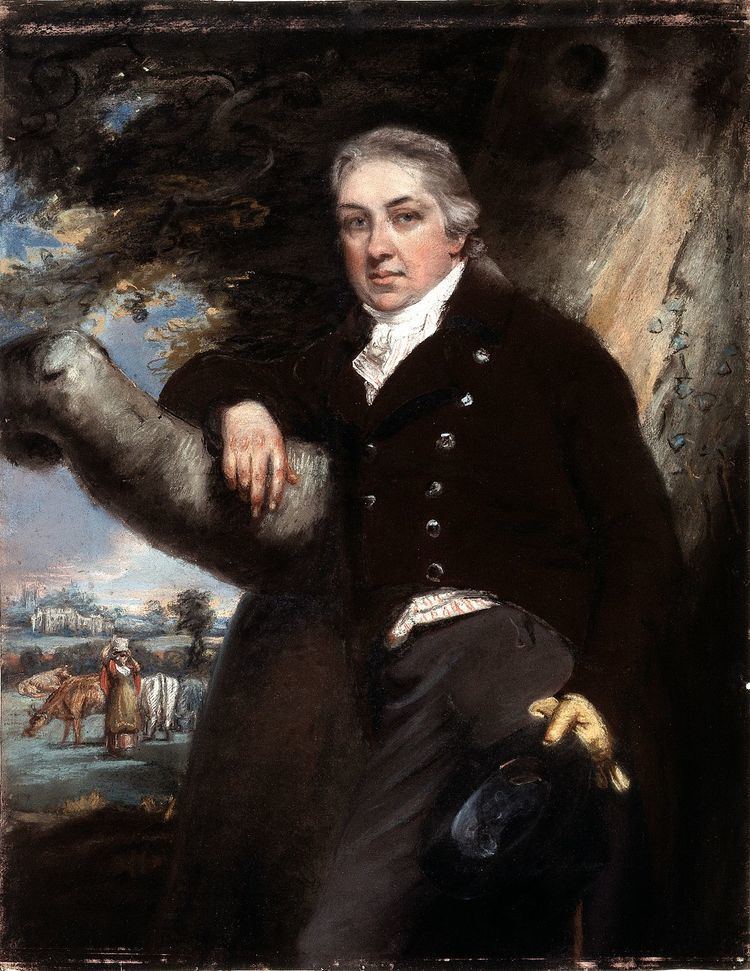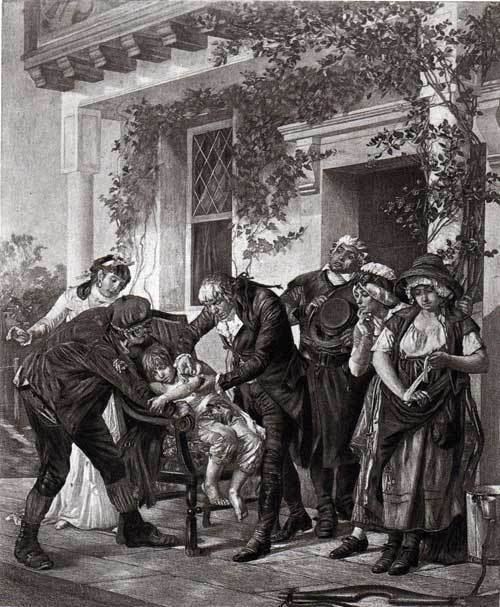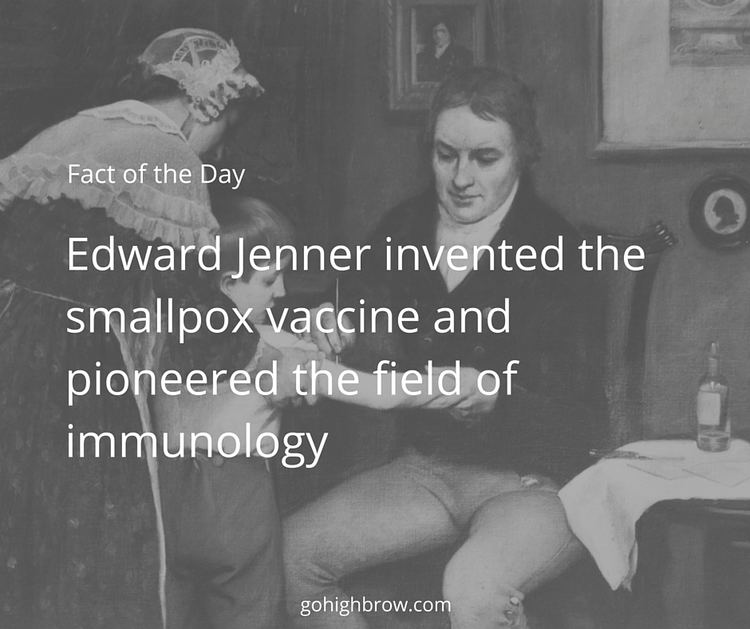Nationality English | Name Edward Jenner Role Physician | |
 | ||
Alma mater St George's, University of LondonUniversity of St Andrews Died January 26, 1823, Berkeley, United Kingdom Spouse Catharine Kingscote (m. 1788–1815) Parents Reverend Stephen Jenner, Sarah Jenner Books Vaccination Against Smallpox Children Edward Robert Jenner, Robert Fitzhardinge Jenner, Catherine Fitzhardinge Jenner Similar People Louis Pasteur, Alexander Fleming, James Phipps, Robert Koch, Lady Mary Wortley Montagu | ||
Biography of edward jenner physician
Edward Jenner, FRS (; 17 May 1749 – 26 January 1823) was an English physician and scientist who was the pioneer of smallpox vaccine, the world's first vaccine. The terms "vaccine" and "vaccination" are derived from Variolae vaccinae (smallpox of the cow), the term devised by Jenner to denote cowpox. He used it in 1796 in the long title of his Inquiry into the Variolae vaccinae known as the Cow Pox, in which he described the protective effect of cowpox against smallpox.
Contents
- Biography of edward jenner physician
- Edward jenner biography of a great thinker
- Early life
- Zoology
- Marriage and human medicine
- Invention of the vaccine
- Later life
- Death
- Religious views
- Legacy
- Monuments and buildings
- Publications
- References

Jenner is often called "the father of immunology", and his work is said to have "saved more lives than the work of any other human". A member of the Royal Society, in the field of zoology he was the first person to describe the brood parasitism of the cuckoo. In 2002, Jenner was named in the BBC's list of the 100 Greatest Britons.

Edward jenner biography of a great thinker
Early life

Edward Anthony Jenner was born on 17 May 1749 (6 May Old Style) in Berkeley, Gloucestershire, as the eighth of nine children. His father, the Reverend Stephen Jenner, was the vicar of Berkeley, so Jenner received a strong basic education.

He went to school in Wotton-under-Edge and Cirencester. During this time, he was inoculated for smallpox, which had a lifelong effect upon his general health. At the age of 14, he was apprenticed for seven years to Daniel Ludlow, a surgeon of Chipping Sodbury, South Gloucestershire, where he gained most of the experience needed to become a surgeon himself. In 1770, Jenner became apprenticed in surgery and anatomy under surgeon John Hunter and others at St George's Hospital. William Osler records that Hunter gave Jenner William Harvey's advice, very famous in medical circles (and characteristic of the Age of Enlightenment), "Don't think; try." Hunter remained in correspondence with Jenner over natural history and proposed him for the Royal Society. Returning to his native countryside by 1773, Jenner became a successful family doctor and surgeon, practising on dedicated premises at Berkeley.

Jenner and others formed the Fleece Medical Society or Gloucestershire Medical Society, so called because it met in the parlour of the Fleece Inn, Rodborough (in Gloucestershire), meeting to dine together and read papers on medical subjects. Jenner contributed papers on angina pectoris, ophthalmia, and cardiac valvular disease and commented on cowpox. He also belonged to a similar society which met in Alveston, near Bristol.
He became a master mason on 30 December 1802, in Lodge of Faith and Friendship #449. From 1812–1813, he served as worshipful master of Royal Berkeley Lodge of Faith and Friendship.
Zoology
Edward Jenner was elected fellow of the Royal Society in 1788, following his publication of a careful study of the previously misunderstood life of the nested cuckoo, a study that combined observation, experiment, and dissection.
He described how the newly hatched cuckoo pushed its host's eggs and fledgling chicks out of the nest (contrary to existing belief that the adult cuckoo did it). Having observed this behaviour, Jenner demonstrated an anatomical adaptation for it—the baby cuckoo has a depression in its back, not present after 12 days of life, that enables it to cup eggs and other chicks. The adult does not remain long enough in the area to perform this task. Jenner's findings were published in Philosophical Transactions of the Royal Society in 1788.
"The singularity of its shape is well adapted to these purposes; for, different from other newly hatched birds, its back from the scapula downwards is very broad, with a considerable depression in the middle. This depression seems formed by nature for the design of giving a more secure lodgement to the egg of the Hedge-sparrow, or its young one, when the young Cuckoo is employed in removing either of them from the nest. When it is about twelve days old, this cavity is quite filled up, and then the back assumes the shape of nestling birds in general." Jenner's nephew assisted in the study. He was born on 30 June 1737.
Jenner's understanding of the cuckoo's behaviour was not entirely believed, until the artist Jemima Blackburn, a keen observer of bird life, saw a blind nestling pushing out a host's egg. Her description and illustration of this were enough to convince Charles Darwin to revise a later edition of On the Origin of Species.
Marriage and human medicine
Jenner married Catherine Kingscote (died 1815 from tuberculosis) in March 1788. He might have met her while he and other fellows were experimenting with balloons. Jenner's trial balloon descended into Kingscote Park, Gloucestershire, owned by Anthony Kingscote, one of whose daughters was Catherine.
He earned his MD from the University of St Andrews in 1792. He is credited with advancing the understanding of angina pectoris. In his correspondence with Heberden, he wrote, "How much the heart must suffer from the coronary arteries not being able to perform their functions."
Invention of the vaccine
Inoculation was already a standard practice, but involved serious risks; among which included the fear that those inoculated would then transfer the disease to those around them due to their becoming carriers of the disease. In 1721, Lady Mary Wortley Montagu had imported variolation to Britain after having observed it in Constantinople. Voltaire wrote that at this time 60% of the population caught smallpox and 20% of the population died of it. Voltaire also states that the Circassians used the inoculation from times immemorial, and the custom may have been borrowed by the Turks from the Circassians.
By 1768, English physician John Fewster had realised that prior infection with cowpox rendered a person immune to smallpox. A similar observation had also been made in France by Jacques Antoine Rabaut-Pommier.
In the years following 1770, at least five investigators in England and Germany (Sevel, Jensen, Jesty 1774, Rendell, Plett 1791) successfully tested a cowpox vaccine in humans against smallpox. For example, Dorset farmer Benjamin Jesty successfully vaccinated and presumably induced immunity with cowpox in his wife and two children during a smallpox epidemic in 1774, but it was not until Jenner's work that the procedure became widely understood. Jenner may have been aware of Jesty's procedures and success.
Noting the common observation that milkmaids were generally immune to smallpox, Jenner postulated that the pus in the blisters that milkmaids received from cowpox (a disease similar to smallpox, but much less virulent) protected them from smallpox.
On 14 May 1796, Jenner tested his hypothesis by inoculating James Phipps, an eight-year-old boy who was the son of Jenner's gardener. He scraped pus from cowpox blisters on the hands of Sarah Nelmes, a milkmaid who had caught cowpox from a cow called Blossom, whose hide now hangs on the wall of the St George's medical school library (now in Tooting). Phipps was the 17th case described in Jenner's first paper on vaccination.
Jenner inoculated Phipps in both arms that day, subsequently producing in Phipps a fever and some uneasiness, but no full-blown infection. Later, he injected Phipps with variolous material, the routine method of immunization at that time. No disease followed. The boy was later challenged with variolous material and again showed no sign of infection.
Donald Hopkins has written, "Jenner's unique contribution was not that he inoculated a few persons with cowpox, but that he then proved [by subsequent challenges] that they were immune to smallpox. Moreover, he demonstrated that the protective cowpox pus could be effectively inoculated from person to person, not just directly from cattle. Jenner successfully tested his hypothesis on 23 additional subjects.
Jenner continued his research and reported it to the Royal Society, which did not publish the initial paper. After revisions and further investigations, he published his findings on the 23 cases. Some of his conclusions were correct, some erroneous; modern microbiological and microscopic methods would make his studies easier to reproduce. The medical establishment deliberated at length over his findings before accepting them. Eventually, vaccination was accepted, and in 1840, the British government banned variolation – the use of smallpox to induce immunity – and provided vaccination using cowpox free of charge. (See Vaccination acts).
The success of his discovery soon spread around Europe and was used en masse in the Spanish Balmis Expedition, a three-year-long mission to the Americas, the Philippines, Macao, China, led by Dr. Francisco Javier de Balmis with the aim of giving thousands the smallpox vaccine. The expedition was successful, and Jenner wrote, "I don’t imagine the annals of history furnish an example of philanthropy so noble, so extensive as this." Napoleon, who at the time was at war with Britain, had all his French troops vaccinated, and at the request of Jenner he released English prisoners of war and permitted their return home. Napoleon remarked he could not "refuse anything to one of the greatest benefactors of mankind."
Jenner's continuing work on vaccination prevented him from continuing his ordinary medical practice. He was supported by his colleagues and the King in petitioning Parliament, and was granted £10,000 in 1802 for his work on vaccination. In 1807, he was granted another £20,000 after the Royal College of Physicians confirmed the widespread efficacy of vaccination.
Later life
In 1803 in London, he became president of the Jennerian Society, concerned with promoting vaccination to eradicate smallpox. The Jennerian ceased operations in 1809. In 1808, with government aid, the National Vaccine Establishment was founded, but Jenner felt dishonoured by the men selected to run it and resigned his directorship. Jenner became a member of the Medical and Chirurgical Society on its founding in 1805 (now the Royal Society of Medicine) and presented several papers there. Jenner was also elected a foreign honorary member of the American Academy of Arts and Sciences in 1802, and a foreign member of the Royal Swedish Academy of Sciences in 1806.
Returning to London in 1811, Jenner observed a significant number of cases of smallpox after vaccination. He found that in these cases the severity of the illness was notably diminished by previous vaccination. In 1821, he was appointed physician extraordinary to King George IV, and was also made mayor of Berkeley and justice of the peace. He continued to investigate natural history, and in 1823, the last year of his life, he presented his "Observations on the Migration of Birds" to the Royal Society.
Death
Jenner was found in a state of apoplexy on 25 January 1823, with his right side paralysed. He never fully recovered and eventually died of an apparent stroke, his second, on 26 January 1823, aged 73. He was buried in the Jenner family vault at the Church of St. Mary's, Berkeley, Gloucestershire. Jenner was survived by one son and one daughter, his elder son having died of tuberculosis aged 21.
Religious views
Neither fanatic nor lax, Jenner was a Christian who in his personal correspondence showed himself quite spiritual; he treasured the Bible. Some days before his death, he stated to a friend: "I am not surprised that men are not grateful to me; but I wonder that they are not grateful to God for the good which he has made me the instrument of conveying to my fellow creatures."
Legacy
In 1979, the World Health Organization declared smallpox an eradicated disease. This was the result of coordinated public health efforts, but vaccination was an essential component. Although the disease was declared eradicated, some pus samples still remain in laboratories in Centers for Disease Control and Prevention in Atlanta in the US, and in State Research Center of Virology and Biotechnology VECTOR in Koltsovo, Novosibirsk Oblast, Russia.
Jenner's vaccine laid the foundation for contemporary discoveries in immunology. In 2002, Jenner was named in the BBC's list of the 100 Greatest Britons following a UK-wide vote. The lunar crater Jenner is named in his honour. Jenner was recognized in the TV show The Walking Dead. In "TS-19", a CDC scientist is named Edwin Jenner.
